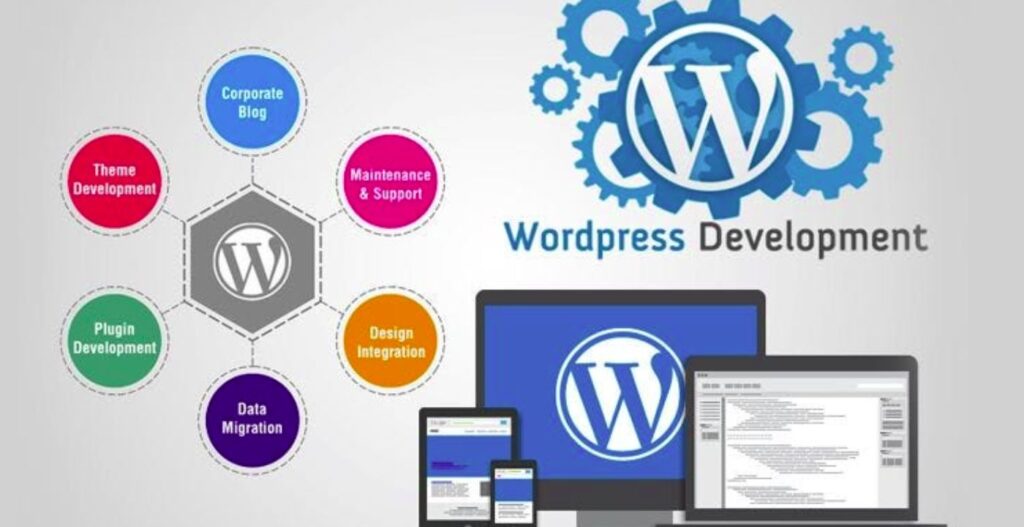WordPress Website Designer:
A WordPress website designer plays a crucial role in bringing your online presence to life, ensuring a seamless and engaging user experience. Let’s dive into the intricacies of this profession, exploring the qualities of a good designer, the process of choosing the right online software house, and the benefits of investing in professional website design.
Importance of a Well-Designed Website

In a digital era where first impressions matter, a well-designed website acts as the virtual storefront for businesses. It not only attracts visitors but also retains them by offering an intuitive and aesthetically pleasing interface.
Role of an Online Software House in Website Design
An online software house serves as a hub for digital solutions, providing a range of services, including website design. Collaborating with a reputable online software house ensures access to a pool of skilled professionals and a streamlined design process.
Whats Qualities of a WordPress Website Designer:
Technical Skills
WordPress website designer possesses a strong command of coding languages, ensuring the seamless integration of features and functionalities.
Understanding of User Experience (UX)
A designer's focus on creating a positive user experience is crucial. Navigability, responsiveness, and user engagement are key factors in ensuring a website's success.
Creativity and Design Aesthetics
Creativity is the soul of design. A designer's ability to create visually appealing layouts and graphics sets the tone for a website's overall appeal.
Knowledge of SEO Principles
Integrating SEO principles into the design process is essential for enhancing a website's visibility on search engines. A designer who understands SEO contributes to the site's overall success.
How Choosing the Right Online Software House:
Research and Reviews
Conducting thorough research and reading client reviews are essential steps in choosing the right online software house. This provides insights into the quality of their work and client satisfaction.
Portfolio Assessment
Reviewing the portfolio of potential online software houses gives a visual representation of their capabilities. Look for diverse projects and attention to detail in their designs.
Communication and Collaboration
Effective communication is key to a successful design project. Choose an online software house that values collaboration and keeps clients involved throughout the design process.
Benefits of Hiring a WordPress Website Designer
Customization Options
Professional designers offer customization options tailored to the specific needs and branding of a business, setting it apart from generic templates.
Time and Cost Efficiency
While initial costs may seem higher, hiring a professional designer saves time and money in the long run. A well-designed website requires fewer revisions and updates.
Professionalism and Expertise
Experienced designers bring professionalism and expertise to the table, ensuring a polished and high-quality end product that aligns with industry standards.
Common Mistakes to Avoid
Ignoring Mobile Responsiveness
In an era dominated by mobile users, neglecting mobile responsiveness can result in a significant loss of potential visitors. A good designer prioritizes responsive design.
Overlooking SEO Optimization
A beautiful website is ineffective if it doesn’t appear in search engine results. Designers should integrate SEO best practices to enhance a site’s visibility.
Lack of Clear Communication with the Designer
Miscommunication can lead to misunderstandings and delays. Establishing clear channels of communication ensures a smooth design process.
Trends in WordPress Website Design

Responsive Design
- The prevalence of mobile devices has made responsive design a staple. Websites that adapt seamlessly to various screen sizes enhance user experience.
Minimalistic Layouts
- Simplicity is elegance. Minimalistic layouts with clean lines and ample white space continue to be a popular design choice for a modern and sophisticated look.
Integration of Multimedia Elements
- Dynamic and engaging websites incorporate multimedia elements like videos and interactive graphics, creating a more immersive user experience.
DIY vs. Professional Design
Pros and Cons of Do-It-Yourself Design
DIY design can be cost-effective, but it often lacks the finesse and functionality of professionally designed websites.
Advantages of Hiring a Professional
Professional designers bring expertise, creativity, and a polished finish to a website, elevating it above amateur designs.
Case Studies: Successful WordPress Website Designs
Showcase of Exemplary Websites
Examining case studies of successful website designs provides inspiration and insights into effective design strategies.
Discussion of Design Elements and Strategies
Analyzing the specific design elements and strategies used in successful projects offers valuable lessons for aspiring designers.
Steps to Collaborate Effectively with a Designer

Establishing Clear Goals
Clearly defined goals guide the design process, ensuring that the final product aligns with the client's vision.
Providing Detailed Feedback
Constructive feedback helps designers understand client preferences, leading to a more personalized and satisfactory end result.
Regular Communication and Updates
Frequent communication and updates keep clients informed and involved, fostering a collaborative and transparent design process.
The Future of WordPress Website Design
Emerging Technologies
The integration of emerging technologies, such as AI and VR, is expected to shape the future of website design, offering innovative and interactive features.
Predictions for Design Trends
Anticipating design trends, such as enhanced personalization and immersive experiences, allows designers to stay ahead in a competitive market.
Final Thoughts
Recap of Key Points
A well-designed website is a powerful tool for online success, and the expertise of a WordPress website designer is instrumental in achieving this.
Importance of a Well-Designed Website for Online Success
In a digital landscape, a visually appealing and functional website is a cornerstone for online success, making the investment in a WordPress website designer worthwhile.
FAQs
The cost varies based on factors like complexity and features. On average, it can range from a few hundred to several thousand dollars.
Yes, WordPress allows easy content updates. A designer can provide training or offer maintenance services for ongoing updates.
The timeline depends on project scope and complexity. Simple sites may take a few weeks, while complex projects can extend to several months.
Yes, purchasing a domain is a separate process. Your designer can guide you on selecting and registering a suitable domain.
Regular updates, backups, and security measures are essential for website maintenance. Designers may offer maintenance packages for ongoing support.


























































